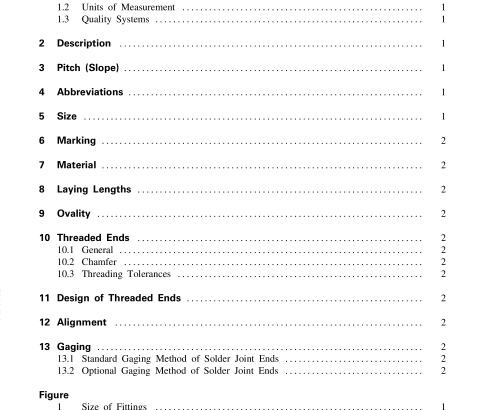ASME B16.29-2001 pdf free download.WROUGHT COPPER AND WROUGHT COPPER ALLOY SOLDER JOINT DRAINAGE FITTINGS – DWV
1.1 General This Standard for wrought copper and wrought copper alloy solder joint drainage fittings, designed for use with copper drainage tube, covers: (a) description
(b) pitch (slope)
(c) abbreviations for end connections
(d) sizes, and method of designating openings for reducing fittings
(e) marking
(f) material
(g) dimensions and tolerances 1.2 Units of Measurement U.S. customary units are the standard.
For conversion to metric SI units, see SI-1, ASME Orientation and Guide for Use of SI (Metric) Units. 1.
Quality Systems Requirements relating to the product manufacturer’s Quality System Programs are described in Nonmanda- tory Appendix B.
2 DESCRIPTION These fittings are designed for drainage and vent systems only, using the solder joint method of connec- tion. The fitting cups (C) are provided with stops so that the ends of the tube, when assembled, meet the stops. Sketches and designs of fittings are illustrative only. The dimensions specified herein shall govern in all cases.
3 PITCH (SLOPE) All nominal 90 deg fittings shall be pitched to result in a slope of 0.25 in./ft (2%) of length of horizontal tube with reference to a horizontal plane.
4 ABBREVIATIONS The symbols in Table 1 are used to designate the type of fitting end.
5 SIZE (a)
The size of the fittings scheduled in the following tables is identified by the corresponding drainage tube size as shown in ASTM B 306. The size of the threaded ends (except slip joints) corresponds to nominal pipe size. (b) Fittings are designated by the size of the openings in the sequence illustrated in Fig. 1. T
he size of the threaded ends will be identified by the corresponding nominal pipe size.
6 MARKING Each fitting shall be marked permanently and legibly with the manufacturer’s name or trademark and with DWV (to indicate drain-waste-vent).
7 MATERIAL Fittings shall be made of wrought copper or wrought copper alloy material having not less than an 84% copper content.
8 LAYING LENGTHS Due to widely varying manufacturing processes, lay- ing length dimensions of fittings are not standardized. Consult the manufacturer for these dimensions.
9 OVALITY Maximum ovality shall not exceed 1% of the maxi- mum diameter shown in Table 2. The average of the maximum and minimum diameters must be within the dimensions shown in the table.
10 THREADED ENDS
10.1 General Fitting threads shall be right-hand, conforming to ASME B1.20.1-1983(R2001). They shall be taper threads (NPT), except for slip joint ends, which shall have straight pipe threads (NPSM).
10.2 Chamfer All internal threads shall be chamfered a distance not less than one-half the pitch of the thread at an angle of approximately 45 deg with the axis of the thread, and all external threads shall be chamfered at an angle of 30 deg to 45 deg from the axis, for the purposes of easier entrance in making a joint and protection of the thread. Chamfering shall be concentric with the threads. The length of threads specified in all tables shall be measured to include the chamfer.
10.3 Threading Tolerances Tapered pipe threads (NPT) shall be checked by use of working plug or ring gages, either standard or limit types. Gages shall be threaded on/in hand tight. The reference point for gaging internal product threads depends upon the chamfer diameter. When the internal chamfer diameter exceeds the major diameter of the internal thread, the reference point is the last thread scratch on the chamfer cone. Otherwise, when the internal chamfer diameter does not exceed the major diameter of the internal thread, the reference point is the end of the fitting. On the external thread, the reference point shall be flush with the end of the fitting. Gaging practices shall be as shown in Notes 3 and 4 of Table 3. Straight pipe threads (NPSM) shall be checked by the use of standard GO and NOT GO plug and ring gages.ASME B16.29 pdf download.ASME B16.29-2001 pdf free download
